Chapter: Cryptography and Network Security Principles and Practice : Asymmetric Ciphers : Public-Key Cryptography and RSA
The RSA Algorithm
THE
RSA ALGORITHM
The pioneering paper by Diffie and Hellman [DIFF76b] introduced a new approach to cryptography and, in effect, challenged cryptologists to come up with a crypto- graphic algorithm that met the requirements for public-key systems. A number of algorithms have been proposed for public-key cryptography. Some of these, though initially promising, turned out to be breakable.4
One of the
first successful responses to the challenge was developed in 1977 by Ron
Rivest, Adi Shamir, and Len Adleman at MIT and first published in 1978 [RIVE78].5 The Rivest-Shamir-Adleman (RSA)
scheme has since
that time reigned supreme as the most widely
accepted and implemented general-purpose approach to public-key encryption.
The RSA scheme is a block cipher in which the plaintext and ciphertext
are integers between 0 and n - 1 for some n. A typical
size for n is
1024 bits, or 309 dec-
imal digits. That is, n is less
than 21024. We examine
RSA in this section in some detail,
beginning with an explanation of the algorithm. Then we examine some of the computational and cryptanalytical implications of RSA.
Description of the Algorithm
RSA makes use of
an expression with exponentials. Plaintext is encrypted in
blocks, with each block having a binary value less than some number
n. That is, the
block size must be less than or equal to log2(n) + 1; in practice, the
block size is i bits, where 2i 6 n £ 2i+1. Encryption and
decryption are of the following form, for some plaintext block M and ciphertext block C.
C = Me mod n
M = Cd mod n = 1Me d mod n = Med mod n
Both sender and receiver must know the value
of n. The sender knows the value of e,
and only the receiver knows the value of
d. Thus, this is a public-key encryption algorithm
with a public key of PU = {e, n} and a private key of PR = {d, n}. For this algorithm to be satisfactory for
public-key encryption, the following require- ments must be met.
1.
It is possible to
find values of e, d, n
such that Med mod
n = M for all M < n.
2.
It is relatively easy to calculate
Me mod n and Cd mod n for all values
of M < n.
3.
It is infeasible to determine d given e and n.
For now, we focus on the first requirement
and consider the other questions later. We need to find a relationship of the
form
Med mod
n = M
The preceding relationship holds if e and d are multiplicative
inverses modulo
ϕ(n), where ϕ(n) is the Euler
totient function. It is shown in Chapter 8 that for p, q prime, ϕ (pq) = (p - 1)(q - 1). The relationship
between e and d can be expressed as
ed
mod ϕ(n) = 1 (9.1)
This is equivalent to saying

That is, e and d are multiplicative inverses mod ϕ(n). Note that, according to the rules of modular arithmetic, this
is true only if d (and therefore e) is relatively prime to ϕ(n). Equivalently, gcd(ϕ(n), d) = 1. See Appendix 9A for a proof that Equation (9.1) satisfies the requirement for RSA.
We are now ready to state the RSA scheme.
The ingredients are the following:
p, q, two prime numbers (private, chosen)
n = pq (public, calculated)
e, with gcd(ϕ(n), e) = 1; 1 < e < ϕ(n) (public, chosen)
d K e-1 (mod ϕ(n)) (private, calculated)
The private key consists of {d, n} and the public key consists of {e, n}. Suppose that user
A has published its public key and that user B wishes to send the message M to
A. Then B calculates C = Me mod n and transmits C. On receipt of this cipher- text, user A decrypts by calculating M = Cd mod n.
Figure 9.5 summarizes the RSA algorithm. It corresponds to Figure 9.1a:
Alice generates a public/private key pair; Bob
encrypts using Alice’s
public key; and
Alice decrypts using her private key. An example from [SING99] is shown in Figure 9.6. For this example, the keys were generated as follows.
1.
Select two prime
numbers, p = 17 and q = 11.
2.
Calculate n = pq = 17 ´ 11 = 187.
3. Calculate ϕ(n) = (p - 1)(q - 1) = 16 ´ 10 = 160.
4.
Select e such that e is relatively prime to ϕ(n) = 160 and less than f(n); we
choose
e
= 7.
5.
Determine d such that de K 1 (mod 160)
and d < 160.
The correct value is d = 23, because 23 ´ 7 = 161 = (1 ´ 160) + 1; d can
be calculated using
the extended Euclid’s algorithm (Chapter 4).
The resulting keys are
public key PU = {7, 187} and
private key PR = {23, 187}. The example shows
the use of these keys for a plaintext input
of M = 88. For encryp- tion, we need to calculate C = 887 mod 187. Exploiting
the properties of modular arithmetic, we can do this as follows.
887 mod 187 = [(884 mod 187) ´ (882 mod 187)
´ (881 mod 187)] mod 187
881 mod 187 = 88
882 mod 187 = 7744 mod 187 = 77
884 mod 187 = 59,969,536 mod 187 = 132
887 mod 187 = (88
´ 77 ´ 132) mod 187 = 894,432 mod 187 = 11
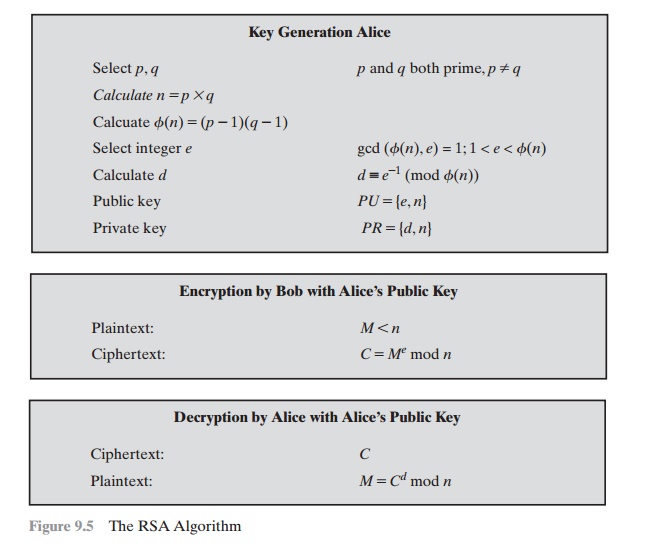
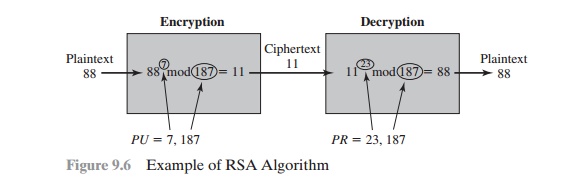
For decryption, we calculate M = 1123 mod 187:
1123 mod 187 = [(111 mod 187) ´ (112 mod 187) ´ (114 mod 187)
´ (118 mod 187) ´ (118 mod 187)] mod 187
111 mod 187 = 11
112 mod 187 = 121
114 mod 187 = 14,641 mod 187 = 55
118 mod 187 = 214,358,881 mod 187 = 33
1123 mod 187 = (11
´ 121 ´ 55 ´
33 ´ 33) mod 187 =
79,720,245 mod 187 = 88
We now look at
an example from [HELL79], which shows the use of RSA
to process multiple blocks of data. In this simple
example, the plaintext is
an alphanumeric string. Each plaintext symbol is assigned a unique code of two decimal digits (e.g., a = 00, A = 26).6 A plaintext block consists of four decimal digits, or two alphanumeric characters. Figure 9.7a illustrates
the sequence of events for
the encryption of multiple blocks, and Figure 9.7b gives a specific example.
The circled numbers indicate the order in
which operations are performed.
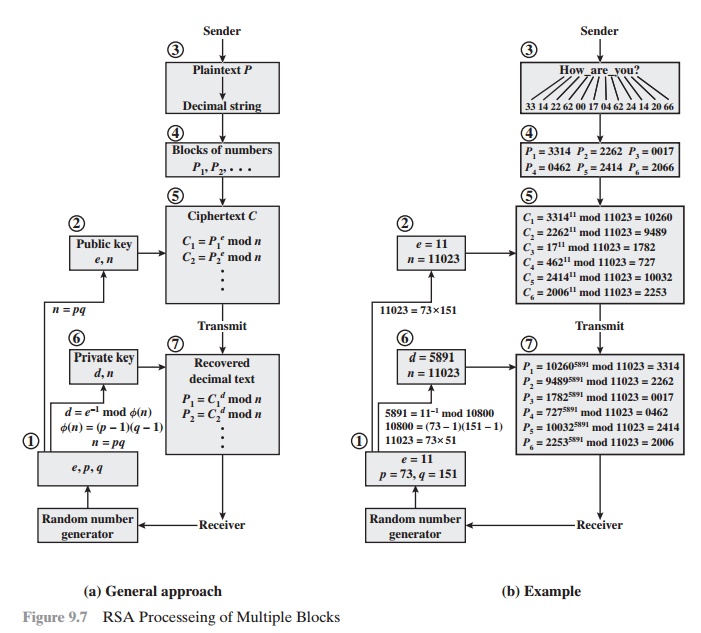
Computational Aspects
We now turn to the issue of the complexity of the computation required to use RSA.
There are actually two issues to consider: encryption/decryption and key
genera- tion. Let us look first at the process of encryption and decryption and then consider key generation.
EXPONENTIATION IN MODULAR ARITHMETIC Both encryption and decryption in RSA involve
raising an integer
to an integer power, mod n. If the exponentiation is done over the integers and then reduced
modulo n, the intermediate values
would be gargantuan. Fortunately, as the preceding
example shows, we can make use of a
property of modular arithmetic:
[(a mod n) * (b mod
n)] mod n = (a * b)
mod n
Thus, we can reduce intermediate results
modulo n. This makes the calculation
practical.
Another consideration is the efficiency of exponentiation, because
with RSA, we are dealing with potentially large exponents. To see how efficiency might be increased,
consider that we wish to compute x16. A straightforward approach requires 15 multiplications:
x16 = x * x * x * x * x * x * x * x * x * x * x * x * x * x * x * x
However, we can achieve the same final
result with only four multiplications if we repeatedly take the square
of each partial
result, successively forming
(x2, x4, x8, x16). As another
example, suppose we wish to calculate x11 mod n for some integers x and
n. Observe that x11 = x1+2+8 = (x)(x2)(x8). In this case, we compute
x
mod n, x2 mod n, x4 mod n, and x8 mod n and then calculate [(x mod n) ´ (x2 mod n) ´ (x8 mod n)] mod n.
More generally, suppose we wish to find the
value ab with
a and m positive integers. If we express b as a binary number bkbk-1.
. . b0, then we have
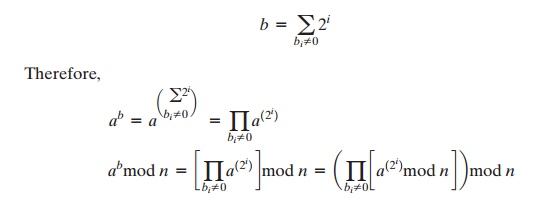
We can therefore develop the algorithm7 for computing ab mod
n, shown in Figure 9.8. Table 9.4 shows an example
of the execution of this algorithm. Note that
the variable c is not needed;
it is included for explanatory purposes. The final value of
c
is the value of the exponent.
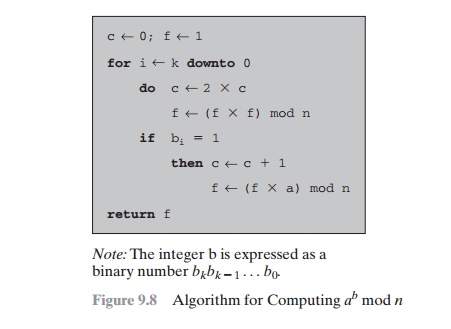
EFFICIENT OPERATION USING THE PUBLIC KEY To
speed up the operation of the RSA
algorithm using the public key, a
specific choice of e is usually made.
The most common choice is 65537 (216 + 1); two other
popular choices are 3 and 17. Each of these
choices has only two 1
bits, so the number of multiplications
required to perform exponentiation is minimized.
However,
with a very small public
key, such as e = 3, RSA becomes
vulnerable to a simple
attack. Suppose we have three
different RSA users
who all use the value e
= 3 but have unique values of n, namely (n1, n2, n3). If user A sends
the same encrypted message M to
all three users, then
the three ciphertexts are C1 = M3 mod n1, C2 = M3 mod n2, and C3 = M3 mod n3. It is likely that n1, n2, and n3 are pairwise rela- tively prime. Therefore, one can use the Chinese
remainder theorem (CRT) to com-
pute M3 mod (n1n2n3). By the rules of the RSA algorithm, M is
less than each of the ni; therefore M3 < n1n2n3. Accordingly, the attacker need only compute the cube root of M3. This attack can be countered by adding a unique pseudorandom bit string as padding
to each instance of M to be encrypted. This approach is discussed
subsequently.
The reader
may have noted that the definition of the RSA algorithm
(Figure 9.5) requires that during key generation the user selects
a value of e that is relatively prime to f(n).Thus, if a value of e is selected first and the primes p and q are generated, it may turn out that gcd(f(n), e)
Z 1. In that case, the user must reject the p, q values and generate a new p, q pair.
Table 9.4 Result
of the Fast Modular Exponentiation Algorithm for ab mod n, where a = 7,
b = 560 = 1000110000, and n = 561

EFFICIENT OPERATION USING
THE PRIVATE KEY
We cannot similarly choose a small constant value of d for efficient operation. A small value
of d is vulnerable to a brute- force attack and to other forms of cryptanalysis [WIEN90]. However,
there is a way to speed up computation using the CRT. We
wish to compute the value M = Cd mod n. Let us define the following
intermediate results:
Vp = Cd mod p Vq = Cd mod q
Following the CRT using Equation (8.8),
define the quantities
Xp = q * (q - 1 mod p) Xq = p * (p - 1 mod q)
The CRT then shows, using Equation (8.9),
that
M = (Vp Xp + Vq Xq) mod n
Furthermore, we can simplify the calculation
of Vp and
Vq using
Fermat’s theorem, which states that ap-1 K 1 (mod p) if p and a are relatively prime. Some thought should convince you that the
following are valid.
Vp = Cd mod p = Cd mod (p -
1) mod p Vq = Cd mod q = Cd mod (q - 1) mod q
The quantities d mod
(p - 1) and d mod
(q - 1) can be precalculated. The end result is that the calculation is approximately four times as fast as evaluating M =
Cd mod n directly [BONE02].
KEY GENERATION Before the application of the public-key cryptosystem,
each participant must generate a pair of keys. This involves the following
tasks.
•
Determining two prime numbers,
p
and q.
•
Selecting either e or d
and calculating the other.
First, consider the selection of p and q. Because the value of n = pq will be known to any potential adversary, in order to
prevent the discovery of p and q by exhaustive methods, these primes
must be chosen
from a sufficiently large set (i.e.,
p and q must be large numbers). On the other hand, the method used for finding
large primes must be reasonably efficient.
At present, there are no useful techniques
that yield arbitrarily large primes, so some
other means of tackling the problem
is needed. The procedure that is generally used is to pick at random an odd number of the
desired order of magni- tude and test whether that number is prime. If not, pick successive random numbers
until one is found that tests prime.
A variety of
tests for primality have been developed (e.g., see [KNUT98] for a description of a number of such tests).
Almost invariably, the tests are prob- abilistic.
That is, the test will merely
determine that a given integer is
probably
prime. Despite this lack of
certainty, these tests can be run in such a way as to make the probability as close to 1.0 as desired. As
an example, one of the more efficient and
popular algorithms, the Miller-Rabin algorithm, is described in
Chapter 8. With this algorithm and most such algorithms, the procedure
for test- ing whether
a given integer n
is prime is to perform some
calculation that involves
n and a randomly chosen integer a. If n
“fails” the test, then n
is not prime. If n “passes” the test, then n may be prime or nonprime. If n passes many such
tests with many different randomly chosen values for a, then we can have high confidence that n is, in fact, prime.
In summary, the procedure for picking a
prime number is as follows.
1.
Pick an odd integer n at random (e.g.,
using a pseudorandom number generator).
2.
Pick an integer
a
< n at random.
3.
Perform the probabilistic primality test, such as Miller-Rabin, with a as a parameter.
If n fails the test, reject the value n and go to step 1.
4.
If n has passed a sufficient number of
tests, accept n; otherwise, go to
step 2.
This is a somewhat tedious procedure.
However, remember that this process is performed relatively infrequently: only
when a new pair (PU, PR) is needed.
It is worth noting how many numbers
are likely to be rejected
before a prime number is found. A result from number theory, known as the prime number theorem,
states that the primes near N are
spaced on the average one every (ln N)
integers. Thus, on average, one
would have to test on the order of ln(N)
integers before a prime is found.
Actually, because
all even integers
can be immediately rejected, the
correct figure is ln(N)/2. For example, if a prime on the order of magnitude of 2200 were sought, then
about ln(2200)/2 = 70 trials would be needed to find a prime.
Having determined prime numbers p and q, the process of key generation is completed by selecting a value
of e and calculating d or, alternatively, selecting a value of d and calculating e. Assuming
the former, then we need to select
an e such that gcd(f(n), e) = 1 and then calculate d K e-1 (mod f(n)). Fortunately, there is a single algorithm that will, at the same time, calculate the greatest common
divisor of two integers
and, if the gcd is 1, determine the inverse of one of the integers
modulo the other. The algorithm, referred to as the extended
Euclid’s algorithm, is explained in Chapter 4. Thus, the procedure is to generate
a series of random num- bers,
testing each against f(n) until a number relatively prime to f(n) is found. Again, we can ask the question: How many random numbers must we test to find a
usable number, that is, a number relatively
prime to f(n)? It can be shown easily that the probability that two random numbers are relatively prime is about 0.6; thus,
very few tests would be needed to find a suitable integer
(see Problem 8.2).
The Security of RSA
Four possible approaches to attacking the
RSA algorithm are
•
Brute force: This
involves trying all possible private keys.
•
Mathematical attacks: There are
several approaches, all
equivalent in effort
to factoring the product
of two primes.
•
Timing attacks: These depend on the running
time of the
decryption algorithm.
•
Chosen ciphertext attacks:
This type of attack
exploits properties of the RSA algorithm.
The defense against the brute-force approach is the same for
RSA as for other cryptosystems, namely, to
use a large key space. Thus, the
larger the number of bits in d, the better. However, because the calculations involved, both in key generation
and
in encryption/decryption, are complex, the larger the size of the key, the slower
the system will run.
In this subsection, we provide an overview of mathematical and
timing attacks.
THE FACTORING PROBLEM We can identify three approaches to attacking RSA
mathematically.
1.
Factor
n
into its two prime factors.
This enables
calculation of ϕ(n)
= (p - 1)
´
(q - 1), which in turn enables determination
of d K e-1 (mod ϕ(n)).
2.
Determine ϕ(n) directly, without first determining p and q. Again, this enables determination of d K e-1 (mod ϕ(n)).
3.
Determine d directly, without first determining ϕ(n).
Most discussions of the cryptanalysis of RSA
have focused on the task of fac- toring
n
into its two prime factors. Determining f(n) given n is equivalent
to factor- ing n [RIBE96].
With presently known algorithms,
determining d given e and n appears to be at least as time-consuming as the factoring problem
[KALI95]. Hence, we can use
factoring performance as a benchmark against which to evaluate the security of RSA.
For a large n with large prime factors, factoring is a hard problem, but it is not as
hard as it used to be. A striking
illustration of this is the
following. In 1977, the three inventors of RSA dared Scientific American readers to decode a cipher they printed in Martin Gardner’s “Mathematical Games” column
[GARD77]. They offered a $100
reward for the return of a plaintext sentence, an event they predicted
might not occur for some 40 quadrillion years. In
April of 1994, a group working over the Internet
claimed the prize after only eight months
of work [LEUT94]. This challenge used a public
key size (length
of n) of 129 decimal
digits, or around
428 bits. In the meantime, just as they had done for DES, RSA Laboratories had issued challenges for the RSA
cipher with key sizes of 100, 110, 120, and so on, digits. The latest challenge to be met is the RSA-200 challenge with a key length
of 200 decimal digits, or about 663 bits. Table 9.5 shows the results to date. The level of effort is measured in MIPS-years: a
Table
9.5 Progress in Factorization
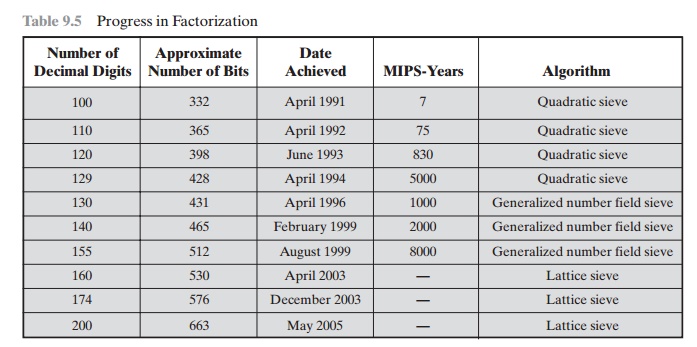
million-instructions-per-second
processor running
for one year, which is about 3 ´x 1013 instructions executed. A 1 GHz Pentium is about a 250-MIPS machine.
A striking fact about Table 9.5 concerns the method used. Until the mid-1990s, factoring attacks were made
using an approach known as the quadratic sieve. The attack on RSA-130 used a newer algorithm, the generalized
number field sieve (GNFS), and was able to factor a larger number than RSA-129
at only 20% of the computing effort.
The threat to larger key sizes is twofold: the continuing increase
in computing power and the continuing refinement of factoring
algorithms. We have
seen that the move to a different
algorithm resulted in a tremendous speedup. We can expect
further refinements in the GNFS, and the use of an even better algorithm
is also a possibility.
In fact, a related algorithm, the special
number field sieve (SNFS), can factor
numbers with a specialized form considerably faster than the generalized number field sieve.
Figure 9.9 compares
the performance of the two algorithms. It is reasonable to expect
a breakthrough that would enable a
general factoring performance in about the same time as SNFS, or even better [ODLY95].
Thus, we need to be careful
in choosing a key
size for RSA. For the near
future, a key size in the range of 1024 to 2048 bits seems reasonable.
In addition to specifying the size of n, a number of other constraints have been
suggested by researchers. To avoid values
of n that may be factored
more easily, the
algorithm’s inventors suggest
the following constraints on p and q.
1.
p and q should
differ in length
by only a few digits.
Thus, for a 1024-bit key (309 decimal digits), both p and
q
should be on the order of magnitude of 1075 to 10100.
2.
Both (p - 1) and
(q - 1) should
contain a large
prime factor.
3.
gcd( p - 1, q - 1) should be small.
In addition, it has been demonstrated that if e <
n
and d < n1/4, then d can be easily
determined [WIEN90].
TIMING ATTACKS If one needed
yet another lesson
about how difficult it is to assess
the security of a cryptographic algorithm, the appearance of timing attacks
provides a stunning one. Paul Kocher, a cryptographic consultant, demonstrated that a snooper can determine a private key by keeping
track of how long a computer takes to
decipher messages [KOCH96,
KALI96b]. Timing
attacks are applicable not just to RSA,
but to other public-key cryptography systems. This attack is alarming
for two reasons: It comes from a completely unexpected direction, and it is a ciphertext-only attack.
A timing attack is
somewhat analogous to a burglar
guessing the combination of a safe by observing how long it takes for someone to turn the dial from number to number. We can explain the attack using the modular exponentiation
algorithm of Figure 9.8, but the attack can be adapted to work with any implementation that does not run in fixed
time. In this algorithm, modular
exponentiation is accomplished bit by bit, with one modular multiplication performed at each
iteration and an addi- tional modular multiplication performed for each 1 bit.
As Kocher points out in his paper, the
attack is simplest to understand in an extreme case. Suppose the target system uses a modular multiplication function that is
very fast in almost all cases but in a few cases takes much more time than an entire average modular exponentiation. The attack proceeds
bit-by-bit starting with the
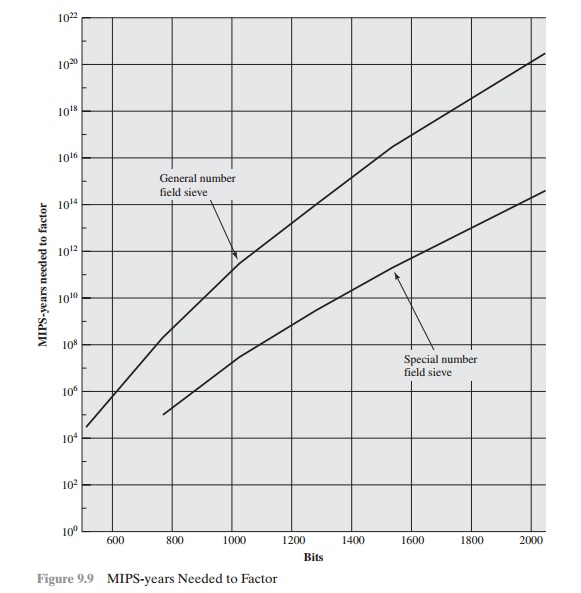
leftmost bit, bk. Suppose that the first j bits are known (to obtain the entire exponent, start with j = 0 and repeat the attack until the entire exponent is known). For a given
ciphertext, the attacker can complete
the first j iterations of the for loop. The operation
of the subsequent
step depends on the unknown exponent bit. If the bit is set, d ; (d ´ a) mod n will be executed. For a few values of a and d, the modular
multiplication will be
extremely slow, and the attacker
knows which these are.Therefore, if the observed time to execute the decryption algorithm is always
slow when this particular iteration is slow with
a 1 bit, then this bit is assumed to be 1. If a number
of observed execution
times for the entire algorithm are fast, then this bit is assumed
to be 0.
In practice, modular exponentiation
implementations do not have such extreme timing variations, in which the
execution time of a single iteration can exceed the mean execution time of the
entire algorithm. Nevertheless, there is enough variation to make this attack
practical. For details, see [KOCH96].
Although the timing attack is a serious
threat, there are simple countermea- sures that can be used, including the
following.
•
Constant exponentiation time:
Ensure that all exponentiations take the same amount of time before returning a result. This is a simple fix but does degrade
performance.
•
Random delay: Better
performance could be achieved by adding a random
delay to the exponentiation algorithm to confuse the timing attack.
Kocher points out that
if defenders don’t add
enough noise,
attackers could still
succeed by collecting additional measurements to compensate for the random
delays.
•
Blinding: Multiply the ciphertext by
a random number before performing exponentiation. This process prevents
the attacker from knowing what cipher-
text bits are being processed inside the computer and therefore prevents the
bit-by-bit analysis essential to the timing
attack.
RSA Data Security incorporates a blinding
feature into some of its products.
The private-key operation M = Cd mod n is
implemented as follows.
1.
Generate a secret random
number r between 0 and n - 1.
2.
Compute C' = C(re) mod n, where e is the public exponent.
3.
Compute M' = (C')d mod n with the ordinary RSA implementation.
4.
Compute M = M'r-1 mod n. In this equation, r-1 is the multiplicative inverse of r mod n;
see Chapter 4 for a discussion of this concept. It can be demonstrated that
this is the correct result by observing that red mod n = r mod
n.
RSA Data Security reports a 2 to 10%
performance penalty for blinding.
CHOSEN CIPHERTEXT ATTACK AND OPTIMAL ASYMMETRIC ENCRYPTION PADDING The
basic RSA algorithm is vulnerable to a chosen ciphertext attack (CCA). CCA is
defined as an attack in which the adversary chooses
a number of ciphertexts and is
then given the corresponding plaintexts, decrypted with the target’s private
key. Thus, the adversary could select a plaintext, encrypt
it with the target’s
public key, and then be
able to get the plaintext
back by having it decrypted
with the private
key. Clearly, this provides
the adversary with no new information. Instead,
the adversary exploits properties of RSA and selects blocks
of data that,
when processed using
the target’s private key, yield information needed for cryptanalysis.
A simple example of a CCA against RSA takes
advantage of the following property of RSA:
E(PU, M1) ´ E(PU, M2) = E(PU, [M1 ´
M2]) (9.2)
We can decrypt C = Me mod n using a CCA as follows.
1.
Compute X = (C ´ 2e) mod n.
2.
Submit X as a chosen ciphertext and receive back Y = Xd mod n.
But now note that
X = (C mod
n) * (2e mod n)
= (Me mod n) * (2e mod n)
= (2M)e mod n
Therefore, Y = (2M) mod n. From this, we can deduce M. To
overcome this simple attack, practical RSA-based cryptosystems randomly
pad the plaintext prior to encryption. This
randomizes the ciphertext so that Equation (9.2) no longer holds. However, more sophisticated CCAs are possible,
and a simple padding with a
random value has been shown to be insufficient to provide the desired security.
To counter such attacks, RSA
Security Inc., a leading RSA vendor and former holder of the RSA patent,
recommends modifying the plaintext using a procedure known as optimal asymmetric encryption padding (OAEP). A full discussion of the threats and OAEP are beyond our scope; see [POIN02] for an introduction and [BELL94a] for a thorough analysis. Here, we simply
summarize the OAEP procedure.
Figure 9.10 depicts OAEP encryption. As a
first step, the message M to be encrypted is padded.A set of optional parameters, P, is passed
through a hash function, H.8 The output
is then
padded with zeros to get the desired
length in the overall data
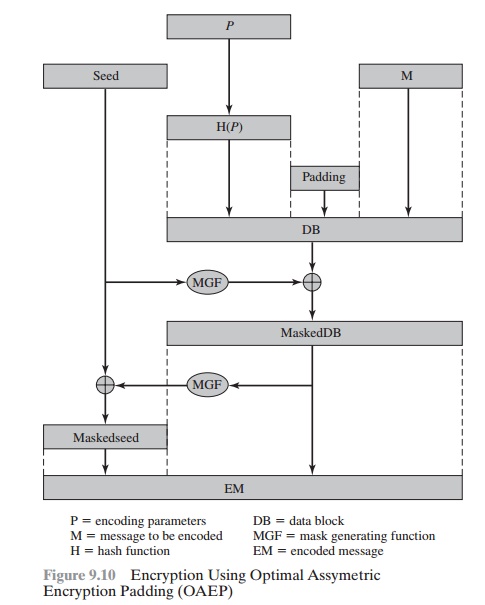
block (DB). Next, a random seed is generated
and passed through
another hash func-
tion, called the mask generating function (MGF). The resulting hash value is bit-by-bit XORed with DB to produce a maskedDB. The maskedDB is
in turn passed through the MGF to form a hash that is XORed with the seed to produce the masked
seed.The concatenation of the maskedseed and the maskedDB forms the encoded
message EM. Note
that the EM includes the padded message, masked
by the seed, and the seed, masked by the maskedDB. The EM is then encrypted using RSA.
Related Topics